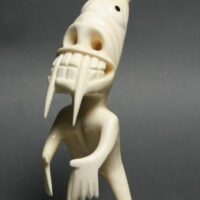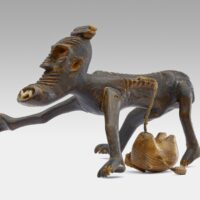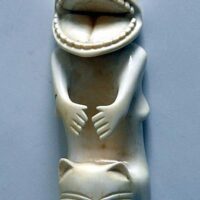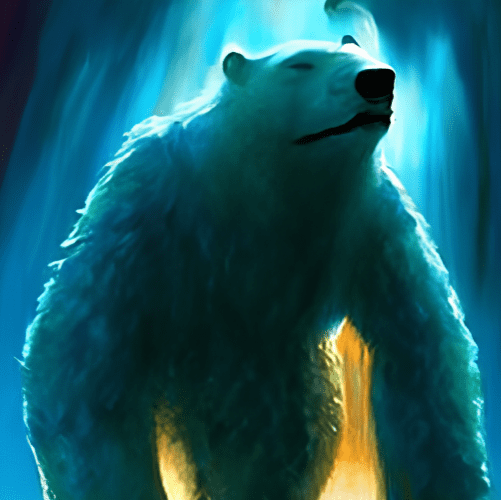Tupilaq : The Vengeful Spirit
Listen
At a glance
| Description | |
|---|---|
| Origin | Inuit Mythology |
| Classification | Spirits |
| Family Members | N/A |
| Region | Greenland, Alaska |
| Associated With | Revenge, Murder |
Tupilaq
Introduction
The Arctic’s harsh environment has not only influenced the daily lives of the Inuit but also their mythological beliefs. Among the various spirits and beings in their folklore, the tupilaq emerges as a particularly chilling symbol of retribution. This creature, prevalent in Greenlandic mythology, is crafted through the skills of practitioners of witchcraft or shamanism, occupying a significant role in Inuit spirituality. Originating from the tales of the Inuit people of Greenland, the Tupilaq embodies the fears and mysteries of the Arctic wilderness. Its eerie presence and formidable powers have fascinated storytellers and scholars, making it a central figure in the cultural landscape of the region.
Physical Traits
The tupilaq’s physical form defies easy categorization, as it manifests as a grotesque fusion of disparate animal parts, meticulously assembled with malicious intent. Constructed from bones, fur, and teeth, it embodies a vengeful spirit, drawing upon whatever materials might hold a grudge. Its appearance ranges from a nightmarish blend of polar bear and walrus to monstrous avian creatures with the limbs of dogs and the claws of wolverines. This unsettling versatility serves as a constant reminder of the capricious nature of revenge.
While commonly depicted as a tangible entity, the tupilaq’s existence extends beyond the physical realm. In some interpretations, it exists solely as an invisible spirit, visible only to shamans or its intended victims. This unseen threat amplifies the psychological terror, looming ominously in the minds of those it seeks to harm.
Fabricated through ritualistic chants and ceremonies, the tupilaq is not a naturally occurring creature but a product of human intervention. Crafted in secrecy from perishable materials, including animal parts and even elements taken from the bodies of children, these creatures are imbued with life through ancient rites. Despite their fearsome reputation, no physical specimens of tupilaq have been preserved, as they are typically created in isolated locations and from materials prone to decay.
Family
The Tupilaq stands alone, devoid of familial ties in the traditional sense. Each entity is a solitary creation, meticulously crafted by a practitioner of witchcraft or shamanism for a specific purpose. Reflecting the materials used in its construction and the intentions of its maker, every Tupilaq is unique in its form and purpose.
Unlike spirits in other mythologies that may serve various roles, the Tupilaq is singularly focused on vengeance. Its existence is rooted in a dark ritual, its purpose unwaveringly tied to rectifying a specific wrongdoing. Though often depicted as a solitary figure in Inuit mythology, some narratives suggest associations with other supernatural beings such as Sedna or Tornarsuk, hinting at a complex web of relationships within the pantheon of Inuit deities and spirits.
Other names
Across Arctic cultures, variations of the Tupilaq exist under different names, such as the “Ijiraq” among the Yupik people of Alaska or the “Qalupalik” among the Inupiat. Despite these regional differences, the concept of a malevolent supernatural being remains consistent in Inuit culture. While “Tupilaq” is widely recognized, regional variations include “terfifalik” in Kalaallisut and other names like “tuurngasuk” and “qalupalik,” reflecting the reverence and fear evoked by this creature. In Inuktitut, it’s referred to as “tupilak” or “ᑐᐱᓚᒃ,” with “tupilait” as the plural form.
Powers and Abilities
The Tupilaq’s powers were as diverse as its form. It could relentlessly stalk its victim, bringing sickness, misfortune, or even death. Some believed it could manipulate the weather, conjuring blizzards or icy winds to torment its target. In its most sinister manifestation, it could possess its victim, driving them to madness or turning them against their loved ones.
Yet, the Tupilaq’s might was not without limitation. Shamans, revered spiritual leaders of the Inuit, held the ability to counter its magic. Through rituals, chants, and protective amulets, they could deflect its attacks or banish it back to the spirit world. This delicate balance allowed for vengeance to be enacted while also providing a means of containment.
The most chilling aspect of the Tupilaq’s power lay in its double-edged nature. If it failed in its mission of vengeance, it would turn on its creator without hesitation. This served as a cautionary tale, reminding practitioners that the flames of vengeance could easily consume even those who ignited them.
Modern Day Influence
Over time, the Tupilaq has evolved from a feared spirit to a cherished piece of Inuit art. Today, artisans craft Tupilaqs of various shapes and sizes from materials like narwhal and walrus tusk, wood, and reindeer antler, forming an integral part of Greenlandic Inuit art and coveted collectibles. These sculptures not only preserve the legends of the Tupilaq but also enrich the cultural traditions of Arctic peoples, echoing their deep-rooted heritage and spiritual beliefs.
While rooted in ancient folklore, the legacy of the Tupilaq resonates in modern times, shaping the cultural identity of its Arctic origins. In Greenland, the Tupilaq has become a symbol of national pride, featured prominently in artwork, literature, and tourism campaigns. Moreover, Inuit artists and storytellers worldwide draw inspiration from the Tupilaq’s mythology, infusing its imagery into contemporary expressions of identity and heritage.
In popular culture, the Tupilaq maintains its influence, appearing across literature, film, and music as a symbol of otherworldly menace and primal terror. From the mesmerizing chants of Inuit throat singers to the spine-chilling narratives of horror writers, the Tupilaq’s ability to evoke awe and fear underscores the enduring power of myth and legend in human psyche.
Despite the waning of traditional Inuit belief systems in some areas, the Tupilaq remains entrenched in modern imagination. Artists find inspiration in its grotesque form, creating sculptures, paintings, and even video game characters based on the creature. Writers incorporate the Tupilaq into their stories, using it as a symbol of past grievances or the destructive consequences of unchecked rage.
Related Images
Frequently Asked Questions
What is lorem Ipsum?
I am text block. Click edit button to change this text. Lorem ipsum dolor sit amet, consectetur adipiscing elit. Ut elit tellus, luctus nec ullamcorper mattis, pulvinar dapibus leo.
What is lorem Ipsum?
I am text block. Click edit button to change this text. Lorem ipsum dolor sit amet, consectetur adipiscing elit. Ut elit tellus, luctus nec ullamcorper mattis, pulvinar dapibus leo.
What is lorem Ipsum?
I am text block. Click edit button to change this text. Lorem ipsum dolor sit amet, consectetur adipiscing elit. Ut elit tellus, luctus nec ullamcorper mattis, pulvinar dapibus leo.
What is lorem Ipsum?
I am text block. Click edit button to change this text. Lorem ipsum dolor sit amet, consectetur adipiscing elit. Ut elit tellus, luctus nec ullamcorper mattis, pulvinar dapibus leo.
What is lorem Ipsum?
I am text block. Click edit button to change this text. Lorem ipsum dolor sit amet, consectetur adipiscing elit. Ut elit tellus, luctus nec ullamcorper mattis, pulvinar dapibus leo.












